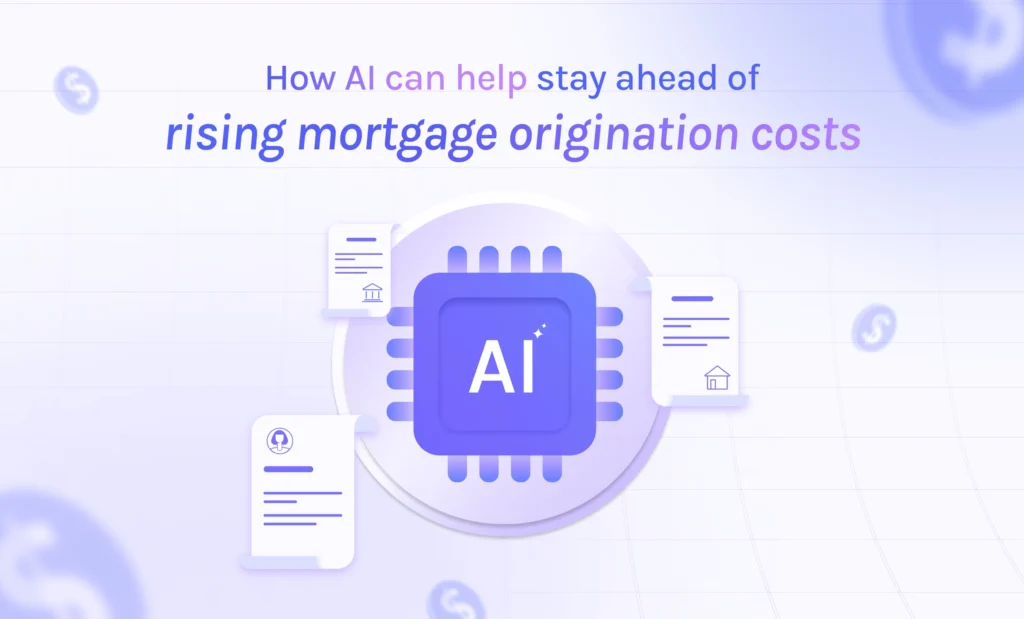This website uses cookies so that we can provide you with the best user experience possible. Cookie information is stored in your browser and performs functions such as recognising you when you return to our website and helping our team to understand which sections of the website you find most interesting and useful.
How AI can help stay ahead of rising mortgage origination costs

According to a recent study by Freddie Mac, mortgage loan origination costs have risen 35% over the past three years. With this trend likely to continue, mortgage lenders must embrace technology to curb operational expenses and stay competitive in a challenging market.
Integrating AI-powered solutions into workflows offers a clear path to reducing costs and positioning lenders for success amid rising costs.
How AI drives down origination costs
Automation can introduce new efficiencies for lenders looking to manage operational costs. Traditionally, lenders have adjusted staffing and investment levels based on active market conditions, reacting to the market rather than proactively planning to scale. This approach comes with costly staffing changes and slow adaptation to changes in demand. By incorporating AI into their workflows, lenders can add flexibility and scalability while minimizing the need to constantly flex their workforce.
AI-driven solutions, like Ocrolus’ document automation, enable lenders to automatically index and extract data from borrower documents, significantly reducing manual data entry and human error. Integrating these tools directly into point-of-sale or loan origination platforms allows lenders to streamline operations, reduce costs and enhance the borrower experience.
Streamlining origination for non-traditional income borrowers
As non-traditional income streams become more common, assessing borrower creditworthiness has become more complex, time-consuming and costly for lenders. AI simplifies this process by automating income analysis with standardized data and consistent calculations. This enables faster and more accurate lending decisions, reducing the risk of errors and the associated costs.
Automating income analysis alleviates the burden on underwriters, freeing them from repetitive “stare and compare” tasks. This shift allows underwriters to focus on building strong customer relationships, enhancing service quality and freeing up valuable time to focus on growing the business.
The critical role of change management
Successfully integrating AI into lending workflows requires effective change management – a structured approach to preparing, supporting and helping individuals and teams adapt to organizational changes when new technologies are introduced.

Proper communication and training can make adopting new technology easier and faster. However, it can also lead to underutilization or even resistance. Lenders must implement a robust change management strategy that ensures all team members understand the benefits of AI and how it enhances their roles.
Ocrolus’ AI Empowered Underwriter certification provides the necessary tools and expertise to support seamless AI adoption. With a clear understanding of AI’s value and how it can help improve their work, lending teams can begin to reap the benefits of AI in reducing cost and complexity in the mortgage lending workflow.
With mortgage origination costs on the rise, adopting AI is crucial. By automating key processes, lenders can reduce costs, improve efficiency, and better serve their customers. However, the success of AI integration hinges on careful planning, effective change management, and a commitment to continuous improvement.
Book a demo to discover how Ocrolus can help you drive down costs with intelligent document automation and analytics.
Key takeaways
- AI-driven automation enables lenders to reduce operational costs and increase scalability by minimizing manual tasks and human error.
- Automating the analysis of non-traditional income streams accelerates lending decisions and frees underwriters to focus on customer relationships.
- Successful AI integration depends on effective change management, including clear communication and comprehensive training for all team members.





